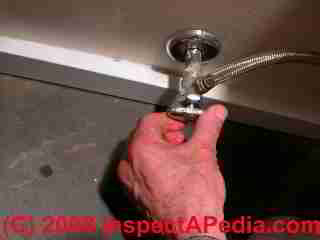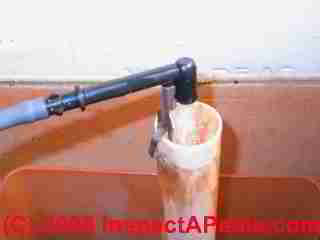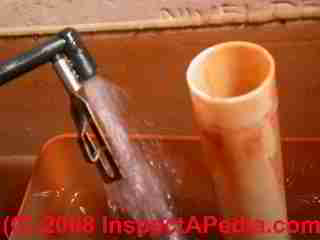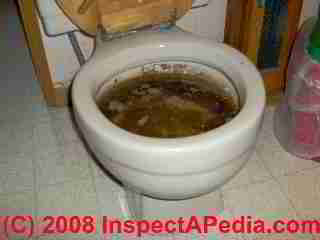 Toilet overflow: how to stop
Toilet overflow: how to stop
- POST a QUESTION or COMMENT about how to stop an overflowing toilet & what to do about cleaning up sewage spills from a toilet overflow
How to stop a toilet from overflowing: this article describes simple and quick steps you can take to stop an overflowing toilet or a toilet whose bowl is filling and that is about to overflow.
Our unpleasant page top photo illustrates the problem with which you may be confronted, often alone, perhaps just after having used the toilet.
Here we explain that quickly lifting the toilet tank lid and taking one or two simple steps can avoid a messy toilet overflow catastrophe.
We also explain how to prevent a septic or sewer system backup during heavy use of a private septic tank and system.
InspectAPedia tolerates no conflicts of interest. We have no relationship with advertisers, products, or services discussed at this website.
- Daniel Friedman, Publisher/Editor/Author - See WHO ARE WE?
Emergency Toilet Overflow Rescue Procedure - how to stop a toilet from overflowing
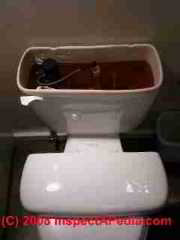 If the toilet is about to overflow here is what you do to prevent sewage from running over the toilet bowl and onto the floor:
If the toilet is about to overflow here is what you do to prevent sewage from running over the toilet bowl and onto the floor:
Take off the toilet tank lid - Quickly but carefully, remove the lid from the toilet tank and set it aside.
You can place the toilet tank lid right across the toilet bowl.
Don't knock the lid on the floor - they break.
Don't waste time moving towels and stuff - we're in a rush to stop the toilet from overflowing.
Reach inside the toilet and push down the flapper valve that is letting the tank empty water into the toilet bowl - this will stop water from entering the toilet and if you're quick enough, prevent sewage from overflowing onto the floor.
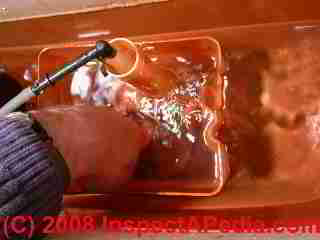
This will be a rubber valve in the center of the bottom of the toilet tank.
This will stop water from flowing from the toilet tank into the toilet bowl.
Don't be afraid to touch the water in the toilet tank or cistern itself.
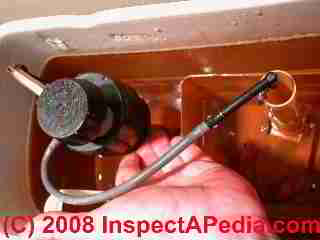
Stop the toilet & its tank from further filling by lifting up the float that operates the toilet tank fill valve.
This will stop water from entering the toilet tank from the toilet supply line.
The photo shows that water is stopped and the flapper in the toilet tank bottom is shut.
If the water level in the toilet bowl is dropping slowly, keep holding the toilet tank float up in its highest position so that water stops flowing into the tank and into the toilet bowl.
Wait a minute - if in the next minute or two the water level in the toilet bowl slowly drops down to a normal level, you'll be able to release the toilet tank float and let the tank and toilet bowl refill without danger of overflowing onto the floor.
If the water level in the toilet tank is not dropping, after a minute or until you can't bear standing there any longer, continue to hold up the toilet tank float while you close the toilet supply valve near the floor or in the wall behind the toilet.
Still holding up the float so that the toilet tank stops filling, reach down and carefully turn off the toilet fill valve. Turn the handle clockwise to close the valve.
If you can't do both, let the float drop and quickly close the valve.
If the toilet supply valve is hard to turn do not force it - it could break and give a terrible supply leak on top of your blocked drain problems.
If you cannot close the toilet fill valve, or if there isn't one, remove the little flexible rubber or plastic tube that is sending water into the toilet bowl through the vertical standpipe.
The photo at left shows this tube in its normal position and you can see it shooting water into the toilet bowl refill tube.
The standpipe also supports the flapper valve but the water squirting into the tube is going right into the toilet bowl.
Aim the flexible little bowl-fill tube into the toilet tank instead.
Now you can let the float drop and let the toilet tank fill.
The reason for this step is that that little tube is sending extra water into the toilet bowl even when the main toilet tank flapper valve has shut.
You're trying to avoid filling and overflowing the toilet tank.
The photo shows us directing the bowl-fill tube water into the toile tank instead.
Once the toilet tank has filled you can clip this tube back in place where as shown in the photo before this one.
OK so You Prevented the Toilet From Overflowing onto the Floor, What Next:
- Stop using all toilets and fixtures: stop running water in sinks and showers etc. while you investigate.
- Try using a toilet plunger to see if you can clear a blocked drain. Don't splash sewage all over yourself, or if you do, wash carefully afterwards. Don't give up too soon. Sometimes repeated plunging for a minute will remove a blockage in a house drain. If during plunging the toilet you see sewage coming up in a nearby tub drain, close the tub drain and try again.
- Investigate the problem to find out the probable cause. Check all of the bathrooms and all plumbing fixtures, starting with the fixtures lowest in the building.
- When checking upper floor fixtures have an accomplice keep an eye on the lower floor toilets and drains - otherwise you may think that upstairs drains are working when in fact they're simply backing up out of the lower floor toilets.
See CLOGGED DRAIN DIAGNOSIS & REPAIR diagnosing septic backups and septic system failures versus clogged drains - for details on how to diagnose blocked drains and septic or sewage backups. - If only one drain or toilet is blocked, is there another bathroom that's working? If so you may have just a local problem and you can survive by not using the problem toilet.
- If all of the toilets or drains are backing up or slow, you may have a blocked system drain or a flooded failing septic field. If so you will have to stop using toilets and sinks indoors. It's possible that after letting the drainfield rest for an hour or so you may be able to return to modest use of toilets. Meanwhile do not run any water into any drains if you can avoid it.
- If your home is connected to a private septic tank, look outside at the septic fields: do you see evidence of septic effluent at the surface? If so, no amount of plunging will correct the problem.
- If your home is connected to a municipal sewer, you may have a blocked main drain.
- If your home uses a sewage ejector pump or septic pump, check that the pump has electrical power, is turned on, and is working. See Pumps Septic pumps, sewage ejector pumps, grinder pumps, effluent pumps, sump pumps, & septic pumping stations compared; pump alarms. Advice.
- Call a plumber to try clearing a blocked drain and or ...
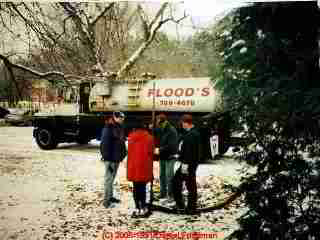
- Call a septic pumping company to ask for an emergency pump out.
This won't fix a broken septic system but if the problem is indeed a flooded drainfield, the empty septic tank will permit your guests to use bathrooms as needed during the event in your home.
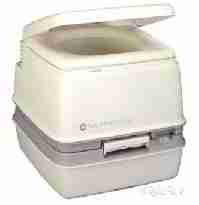
Use a portable or chemical toilet: Call a port-a-john portable toilet company, if all else fails and you have lots of guests who will be in the building over an extended time.
You can rent one or more portable toilets.
In a pinch you may be able to borrow a camping toilet or chemical toilet like this Thetford porta-potty from someone who has that device.
If you have had sewage back up and spill out of toilets into the building, cleanup is needed and you may face bacterial hazards.
See SEWAGE CONTAMINATION in BUILDINGS for advice.
Why Does the Septic or Sewer System Back Up During a Party?
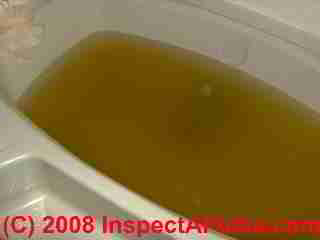
Indeed it seems to be just the luck that we are living happily along not giving the septic tank a thought until we have a bunch of guests over for Thanksgiving, Chanukah, Christmas, or a graduation party. Why is it that at events we often see the septic system backing up?
The photo shows sewage water backing up into a bath tub. This is what can happen at bottom floor fixtures in a home when the main drain is blocked or the septic system is blocked and you keep flushing toilets or running fixtures at upper floors. Don't do this.
Septic systems seem to fail during a party because the septic system was already in trouble, but our usage was modest enough that we just weren't noticing it.
The surge of waste water entering the septic tank cannot flow into a flooded drainfield so sewage may back up into the home, usually at the lowest plumbing fixture. Sometimes it's not the wastewater surge but someone flushing something down a toilet that blocks a drain - that's a problem that can be cleared by a plumber using a plumbing snake or drain router. But often the problem is in the septic field itself.
Readers should see CAMPING & EMERGENCY TOILETS and also s
ee ALTERNATIVE & WATERLESS TOILETS for a discussion of camping toilets, chemical toilets, emergency-use toilets, waterless toilets, graywater systems, composting toilets, home health care toilets, incinerating toilets, outhouses, and latrines.
...
Reader Comments, Questions & Answers About The Article Above
Below you will find questions and answers previously posted on this page at its page bottom reader comment box.
Reader Q&A - also see RECOMMENDED ARTICLES & FAQs
On 2019-01-21 - by (mod) -
Kathleen
Once the toilet tank and bowl have filled after a flush, turn off the water supply valve to the toilet.
That will prevent more than one tank of water from leaking down the drain and can avoid a frozen drain pipe.
If you let the toilet run and it's very cold out a shallow outdoor sewer or drain line could freeze and even break, causing costly sewer line repairs and even a worse sewer backup in the building.
The ARTICLE INDEX near the end of the article on this page gives links to articles on diagnosing and fixing a RUNNING TOILET
On 2019-01-20 by Kathleen
Toilet running constantly. Will be repaired in a couple of days. Meanwhile it is good for a couple of flushes and then we turn water off after it refills. Trying to save water. Supposed to drop to 7 degrees Tonite and tomorrow.
Should I turn valve back on so it won't freeze. I rather pay for some wasted water rather than burst pipes. Tankless hot water/furnace in garage but I don't know where water for toilet pipes are.
On 2017-11-13 by T
Thank you for this! I'm a renter and this helped mitigate a midnight overflow.
On 2016-02-11 - by (mod) -
It sounds as if there is a toilet drain blockage but perhaps not close to the toilet. Try longer, patient plunging. Sometimes 5 minutes or so will work.
Flush the toilet, taking care not to let it overflow (as described in the article above). With the bowl full try plunging for 4-5 minutes, forcing water into the drain. The water level should drop some as you force water into the drain line - that may help free a blockage.
IF that doesn't work I'm afraid you need to call a plumber.
On 2016-02-11 - by (mod) -
It sounds as if there is a toilet drain blockage but perhaps not close to the toilet.
Try longer, patient plunging. Sometimes 5 minutes or so will work. IF that doesn't work I'm afraid you need to call a plumber.
On 2016-02-11 by Mary
Hi, I'm hoping someone can help me so I don't have to call a plumber :-) I went to use my toilet and noticed the water level was extremely low (just enough to see where the flush hole is). I didn't think much of it and used the toilet. I flushed and the water just rose up in the bowl to the top. I have tried plunging multiple, multiple times and nothing unclogs. I then tried a snake and got the same result.
I did not feel the snake bump into anything. In both cases, no organic material or debris appeared and the water remains practically clear.
I also tried the home remedy of vinegar, baking soda and hot water and let that sit overnight. In the morning, the water level was again extremely low but when I flushed, it still rose to the top. I've looked in the holding tank and everything looks intact. Nothing broken off and the chain is still intact as well.
I am completely stumped. Any other troubleshooting suggestions out there for me? Thanks a lot!
On 2015-05-12 by DanialThomas
Good information shared. This information is helpful in emergency condition.
Thanks
PPplumbing
On 2015-02-22 - by (mod) -
Helen we don't know from your note if the problem was a frozen drain, blocked drain, or failed septic system. The last is likely to be the most costly.
Don't forget to check for and fix any running toilets or dripping faucets as those slow outflows can freeze up and block a shallow drain line n cold weather.
On 2015-02-17 by Helen M
Freezing cold temperatures outside and 2 feet of snow. We have a septic tank. Basement toilet is overflowing when toilets are flushed upstairs or when washingmachine is on. Just noticed this tonight. Septic was last pumped 2.5 years ago and we were told it looked fine. Original septic 1976. My husband thinks a drain pipe outside may be frozen and causing back-up. All water is usage has stopped in the house. Water coming up from basement toilet looks muddy(fecal Matter) and bits of tissue. How bad is this? W. Spfld,Mass.
On 2014-03-30 by (mod)
Marie,
That "gurgling" noise suggests that either the main drain is partly blocked (most likely) or the vent system is not functioning. If the problem has always been there one might suspect the vent but otherwise it's time to ask a plumber to check and unclog the main drain.
On 2014-03-29 by MARIE
My toilet always clogs up when you do #2. I have been able to unclog by using a plunger and it take a while to unclog. I tested the toilet by pouring a bucket of water down the toilet, I can hear a gurgling noise once all the water drains out and also when I use the plunger. When you first unclog and flush , dirt is always in the bottom of the toilet.
...
Continue reading at TOILET REPAIR GUIDE or select a topic from the closely-related articles below, or see the complete ARTICLE INDEX.
Or see these
Recommended Articles
- BLOCKED DRAIN REPAIR METHODS to try clearing your blocked drain before going to more drastic measures.
- TOILET REPAIR GUIDE
Suggested citation for this web page
TOILET OVERFLOW EMERGENCY at InspectApedia.com - online encyclopedia of building & environmental inspection, testing, diagnosis, repair, & problem prevention advice.
Or see this
INDEX to RELATED ARTICLES: ARTICLE INDEX to TOILET INFORMATION
Or use the SEARCH BOX found below to Ask a Question or Search InspectApedia
Ask a Question or Search InspectApedia
Try the search box just below, or if you prefer, post a question or comment in the Comments box below and we will respond promptly.
Search the InspectApedia website
Note: appearance of your Comment below may be delayed: if your comment contains an image, photograph, web link, or text that looks to the software as if it might be a web link, your posting will appear after it has been approved by a moderator. Apologies for the delay.
Only one image can be added per comment but you can post as many comments, and therefore images, as you like.
You will not receive a notification when a response to your question has been posted.
Please bookmark this page to make it easy for you to check back for our response.
IF above you see "Comment Form is loading comments..." then COMMENT BOX - countable.ca / bawkbox.com IS NOT WORKING.
In any case you are welcome to send an email directly to us at InspectApedia.com at editor@inspectApedia.com
We'll reply to you directly. Please help us help you by noting, in your email, the URL of the InspectApedia page where you wanted to comment.
Citations & References
In addition to any citations in the article above, a full list is available on request.
- [1] "Remediation of Sewage Contaminated Crawlspaces", Byjim Holland, CR, "Cleaning and Restoration," July 1999, pp 22-24, original source: restcon.com/links/articles/Remediating%20Contaminated%20Crawlspaces.pdf
- Benson, A., ed. (1990) Control of Communicable Diseases in Humans, American Public Health Association, Washington, DC.
- Berry, M.A. (1993) Protecting the Built Environment: Cleaning for Health, Tricomm 21st press, Chapel Hill, NC, p. 185.
- Block, S.S. (1991) Disinfection, Sterilization, and Preservation, Lea & Febiger, Philadelphia, PA.
- Rogers, S.A. (1991) Indoor fungi as part of the cause of recalcitrant symptoms of the tight building syndrome. Env. International. 17:271-275.
- Clark, C.S. (1987) Potential and actual biological related health risks of waste water industry employment. J. Water Pollution Control. Fed. 59:12999-1008.
- Cole, E.C. (1989) Remedial measures for biological pollutants in the home. Workshop on Biological Pollutants in the Home. U.S. Consumer Product Safety Commission, American Lung Association.
- Cole, E.C. (1987) The application of disinfection and sterilization to infectious waste management. In: Tulis, J.J. and W. R. Thomann (eds.), Proceedings of strategies for improved chemical and biological waste management for hospitals and clinical laboratories. Duke University, University of North Carolina, North Carolina Pollution Pays Program.
- Cutter Information Corp. (1991) Indoor Air Quality Update, Arlington, VA.
- Foarde, K.K.; D. Bush; J. Chang; E.C. Cole; D. Franke; and D. Van Osdell. (1992) Characterization of environmental chambers for evaluating microbial growth on building materials. IAQ 92, ASHRAE, San Francisco.
- International Institute of Carpet and Upholstery Certification. (1991) Carpet Cleaning Standard. S001-1991, International Institute of Carpet and Upholstery Certification, Vancouver, WA, 1991.
- Patterson, R.; J.N. Fink; W.B. Miles. (1981) Hypersensitivity lung disease presumptively due to cephalosporium in homes contaminated by sewage flooding or humidifier water. J. Allergy Clin. Immunol. 68(2):128-132.
- Robertson, K.A.; T.K. Ghosh; A.L. Hines; S.K. Loyalka; D. Novosel; R.C. Warder, Jr. (1990) Airborne microorganisms: their occurrence and removal. Indoor Air '90, Toronto.
- Rogers, S.A. (1991) Indoor fungi as part of the cause of recalcitrant symptoms of the tight building syndrome. Env. International. 17:271-275.
- Rutala, W.A.; E.C. Cole; and N.S. Wannamaker. (1991) Inactivation of Mycobacterium tuberculosis and Mycobacterium bovis by 14 Hospital Disinfectants. Amer J. Med. 91:2675-2715.
- Rutala, W.A. (1987) Disinfection, sterilization and waste disposal. In: Wenzel, R.P., Prevention and control of nosocomial infections. Williams and Wilkins, Baltimore.
- Escherichia coliO157:H7- US CDC
- Demistifying Ecoli - Federation of Ontario Cottagers
- Microbiology home page - US EPA
- Cost effective testing for blackwater contamination in buildings Aerotech Labs
- Indicator organisms, testing for sewage contamination in buildings Aerotech Labs
- Sewage and Septic Contamination in Residential Buildings - consumer information and expert resources (this web page)
- Sewage Pathogens in Septic Tank Sludge and Floating Scum: what makes up the contents of residential sewage
- [9] Amahmid, O., Asmama, S., & Bouhoum, K. (1999). The effect of waste water reuse in irrigation on the contamination level of food crops by Giardia cysts and Ascaris eggs. International Journal of Food Microbiology, 49(1-2), 19-26.
- [10] Barak, J.D., Whitehand, L.C., & Charkowski, A.O. (2002). Differences in attachment of Salmonella enterica serovars and Escherichia coli O157:H7 to alfalfa sprouts. Applied and Environmental Microbiology, 68(10), 4758-4763.
- [11] Beuchat, L.R. (1996). Pathogenic microorganisms associated with fresh produce. Journal of Food Protection, 59(2), 204-216.
- [12] Breuer, T., Benkel, D.H., Shapiro, R.L., Hall, W.N., Winnett, M.M., Linn, M.J., Timothy, J.N., Barrett, J., Dietrich, S., Downes, F.P., Toney, D.M., Pearson, J.L., Rolka, H., Slutsker. L., & Griffin, P.M. (2001). A multi-state outbreak of Escherichia coli O157:H7 infections linked to alfalfa sprouts grown from contaminated seeds. Emerging Infectious Diseases, 7(6), 977-982.
- [13] Castro-Rosas, J., & Escartin, E.F. (2000). Survival and growth of Vibrio cholerae O1, Salmonella typhi, and Escherichia coli O157:H7 in alfalfa sprouts. Journal of Food Science, 65(1), 162-165.
- [14] Charkowski, A.O., Barak, J.D., Sarreal, C.Z., & Mandrell, R.E. (2002). Growth and colonization patterns of Salmonella enterica and Escherichia coli O157:H7 on alfalfa sprouts and the effects of sprouting temperature, i inoculum /in·oc·u·lum/ (-ok´u-lum) pl. inoc´ula material used in inoculation.
- [15] Evans, M.R., Ribeiro, C.D., & Salmon, R.L. (2003). Hazards of healthy living: Bottled water and salad vegetables as risk factors for Campylobacter infection. Emerging Infectious Disease, 9(10), 1219-1225.
- [16] Frost, J.A., McEvoy, M.B., Bentley, C.A., Andersson, Y., & Rowe, B. (1995). An outbreak of Shigella sonnei infection associated with consumption of iceberg. Emerging Infectious Disease, 1(1), 26-28.
- [17] Guo, X., Chen, J., Brackett, R.E., & Beuchat, L.R. (2001). Survival of Salmonellae on and in tomato plants from the time of inoculation at flowering and early stages of fruit development through fruit ripening, said of meat. See curing. . Applied and Environmental Microbiology, 67(10), 4760-4764.
- [18] Guo, X., Chen, J., Brackett, R.E., & Beuchat, L.R. (2002). Survival of Salmonellae on tomatoes stored at high relative humidity, in soil, and on tomatoes in contact with soil. Journal of Food Protection, 65(2), 274-279.
- [19] Guo, X., Iersel, M.W.V., Chen, J., Brackett, R.E., & Beuchat, L.R. (2002). Evidence of association of salmonellae with tomato plants grown hydroponically in inoculated nutrient solution. Applied and Environmental Microbiology, 68(7), 3639-3643.
- [20] Itoh, Y., Sugita-Konishi, Y., Kasuga, E, Iwaki, M., Hara-Kudo, Y., Saito, N., Noguchi, Y, Konuma, H., & Kumagai, S. (1998) Enterohemorrhagic Escherichia coli enterohemorrhagic Escherichia coli EHEC Any of the E coli serotypes–eg O29, O39, O145 that produces shiga-like toxins, causing bloody inflammatory diarrhea, evoking a HUS. See Escherichia coli O157:H7, Hemolytic uremic syndrome. O157:H7 present in radish sprouts. Applied and Environmental Microbiology, 64(4), 1532-1535.
- [21] Madden, J.M. (1992). Microbial pathogens in fresh produce--The regulatory perspective. Journal of Food Protection, 55, 821-823.
McMahon, M.A.S., & Wilson, I.G. (2001). The occurrence of enteric pathogens and Aeromonas species in organic vegetables. International Journal of Food Microbiology, 70(1-2),155-162. - [22] Puohiniemi, R., Heiskanen, T., & Siitonen, A. (1997). Molecular epidemiology of two international sprout-borne Salmonella outbreaks. Journal of Clinical Microbiology . 35(10), 2487-2491.
- [23] Shearer, A.E., Strapp, C.M., & Joerger, R.D. (2001). Evaluation of polymerase chain reaction-based system for detection of Salmonella enteritidis, Escherichia coli O157:H7, Listeria spp., and Listeria monocytogenes on fresh fruit and vegetables. Journal of Food Protection, 64(6), 788-795.
- [24] Takeuchi, K., Hassan, A.N., & Frank, J.F. (2001). Penetration of Escherichia coli O157:H7 into lettuce as influenced by modified atmosphere and temperature. Journal of Food Protection, 64(11), 1820-1823.
- [25] Wright, C., Kominos, S.D., & Yee, R.B. (1976). Enterobacteriaceae and Pseudomonas aeruginosa recovered from vegetable salads. Applied and Environmental Microbiology, 31(3), 453-454.
- [26] Thanks to reader Charles Labs at 247inktoner.com Tel: 800-866-8022 (a provider of ink toner, ink cartridges and related supplies) for updating our CDC link on e-Coli 4/19/2013.
- Advanced Onsite Wastewater Systems Technologies, Anish R. Jantrania, Mark A. Gross. Anish Jantrania, Ph.D., P.E., M.B.A., is a Consulting Engineer, in Mechanicsville VA, 804-550-0389 (2006). Outstanding technical reference especially on alternative septic system design alternatives. Written for designers and engineers, this book is not at all easy going for homeowners but is a text I recommend for professionals--DF.
- Country Plumbing: Living with a Septic System, Hartigan, Gerry: $ 9.95; ALAN C HOOD & TP; Quoting an Amazon reviewer's comment, with which we agree--DF
- US EPA ONSITE WASTEWATER TREATMENT SYSTEMS MANUAL [online copy, free] Top Reference: US EPA's Design Manual for Onsite Wastewater Treatment and Disposal, 1980, available from the US EPA, the US GPO Superintendent of Documents (Pueblo CO), and from the National Small Flows Clearinghouse. Original source http://www.epa.gov/ORD/NRMRL/Pubs/625R00008/625R00008.htm Onsite wastewater treatment and disposal systems, Richard J Otis, published by the US EPA. Although it's more than 20 years old, this book remains a useful reference for septic system designers. U.S. Environmental Protection Agency, Office of Water Program Operations; Office of Research and Development, Municipal Environmental Research Laboratory; (1980)
- Eco John® Innovative Toilet Solutions, Global Inventive Industries, Fountain Valley CA, PDF, product brochure
- "International Private Sewage Disposal Code," 1995, BOCA-708-799-2300, ICBO-310-699-0541, SBCCI 205-591-1853, available from those code associations.
- "Manual of Policy, Procedures, and Guidelines for Onsite Sewage Systems," Ontario Reg. 374/81, Part VII of the Environmental Protection Act (Canada), ISBN 0-7743-7303-2, Ministry of the Environment,135 St. Clair Ave. West, Toronto Ontario M4V 1P5 Canada $24. CDN.
- Manual of Septic Tank Practice, US Public Health Service's 1959.
- Onsite Wastewater Disposal, R. J. Perkins; Quoting from Amazon: This practical book, co-published with the National Environmental Health Association, describes the step-by-step procedures needed to avoid common pitfalls in septic system technology. Valuable in matching the septic system to the site-specific conditions, this useful book will help you install a reliable system in both suitable and difficult environments. Septic tank installers, planners, state and local regulators, civil and sanitary engineers, consulting engineers, architects, homeowners, academics, and land developers will find this publication valuable.
- Onsite Wastewater Treatment Systems, Bennette D. Burks, Mary Margaret Minnis, Hogarth House 1994 - one of the best septic system books around, suffering a bit from small fonts and a weak index. While it contains some material more technical than needed by homeowners, Burks/Minnis book on onsite wastewater treatment systems a very useful reference for both property owners and septic system designers.
- SEPTIC SOIL & PERC TESTS soil perc testing guide and instructions
- Percolation Testing Manual, CNMI Division of Environmental Quality, PO Box 501304, Saipan, MP 96950
- Planting Over Septic System Component", Daniel Friedman (author/editor, InspectAPedia.com), The Innovator, Winter/Spring 2008, BCOSSA, British Columbia OnSite Sewage Association, 201-3542 Blansard St., Victoria BC V8X 1W3 Canada
- Save the Septic System - Do Not Flush These Items Down the Toilet, Daniel Friedman, InspectAPedia.com - PDF document, printable
- Septic System Owner's Manual, Lloyd Kahn, Blair Allen, Julie Jones, Shelter Publications, 2000 $14.95 U.S. - easy to understand, well illustrated, one of the best practical references around on septic design basics including some advanced systems; a little short on safety and maintenance. Both new and used (low priced copies are available, and we think the authors are working on an updated edition--DF. Quoting from one of several Amazon reviews: The basics of septic systems, from underground systems and failures to what the owner can do to promote and maintain a healthy system, is revealed in an excellent guide essential for any who reside on a septic system. Rural residents receive a primer on not only the basics; but how to conduct period inspections and what to do when things go wrong. History also figures into the fine coverage.
- US EPA ONSITE WASTEWATER TREATMENT SYSTEMS MANUAL Top Reference: US EPA's Design Manual for Onsite Wastewater Treatment and Disposal, 1980, available from the US EPA, the US GPO Superintendent of Documents (Pueblo CO), and from the National Small Flows Clearinghouse. Original source http://www.epa.gov/ORD/NRMRL/Pubs/625R00008/625R00008.htm
- Water Wells and Septic Systems Handbook, R. Dodge Woodson. This book is in the upper price range, but is worth the cost for serious septic installers and designers.
Quoting Amazon: Each year, thousands upon thousands of Americans install water wells and septic systems on their properties. But with a maze of codes governing their use along with a host of design requirements that ensure their functionality where can someone turn for comprehensive, one-stop guidance? Enter the Water Wells and Septic Systems Handbook from McGraw-Hill.
Written in language any property owner can understand yet detailed enough for professionals and technical students this easy-to-use volume delivers the latest techniques and code requirements for designing, building, rehabilitating, and maintaining private water wells and septic systems. Bolstered by a wealth of informative charts, tables, and illustrations, this book delivers:
* Current construction, maintenance, and repair methods
* New International Private Sewage Disposal Code
* Up-to-date standards from the American Water Works Association - Wells and Septic System, Alth, Max and Charlet, Rev. by S. Blackwell Duncan, $ 18.95; Tab Books 1992. We have found this text very useful for conventional well and septic systems design and maintenance --DF. Quoting an Amazon description:Here's all the information you need to build a well or septic system yourself - and save a lot of time, money, and frustration. S. Blackwell Duncan has thoroughly revised and updated this second edition of Wells and Septic Systems to conform to current codes and requirements. He also has expanded this national bestseller to include new material on well and septic installation, water storage and distribution, water treatment, ecological considerations, and septic systems for problem building sites.
- The NSFC Products List has an excellent list of design manuals/modules National Small Flows Clearinghouse (NSFC) now (2019/12/13) hosted at http://www.nesc.wvu.edu/ Tel: 304-293-4191 e-mail info@mail.nesc.wvu.edu.
he National Small Flows Clearinghouse (NSFC) was funded by the U.S. Environmental Protection Agency (EPA) to help America's small communities and individuals solve their wastewater problems through objective information about onsite wastewater collection and treatment systems. NSFC products and information are the only national resource of its type, dealing with small community wastewater infrastructure. or by telephone 800-624-8301 - Our recommended books about building & mechanical systems design, inspection, problem diagnosis, and repair, and about indoor environment and IAQ testing, diagnosis, and cleanup are at the InspectAPedia Bookstore. Also see our Book Reviews - InspectAPedia.
- In addition to citations & references found in this article, see the research citations given at the end of the related articles found at our suggested
CONTINUE READING or RECOMMENDED ARTICLES.
- Carson, Dunlop & Associates Ltd., 120 Carlton Street Suite 407, Toronto ON M5A 4K2. Tel: (416) 964-9415 1-800-268-7070 Email: info@carsondunlop.com. Alan Carson is a past president of ASHI, the American Society of Home Inspectors.
Thanks to Alan Carson and Bob Dunlop, for permission for InspectAPedia to use text excerpts from The HOME REFERENCE BOOK - the Encyclopedia of Homes and to use illustrations from The ILLUSTRATED HOME .
Carson Dunlop Associates provides extensive home inspection education and report writing material. In gratitude we provide links to tsome Carson Dunlop Associates products and services.


